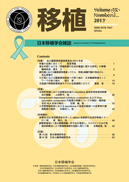Volume 55, Issue 3
Displaying 1-22 of 22 articles from this issue
- |<
- <
- 1
- >
- >|
-
2020Volume 55Issue 3 Pages 125-131
Published: 2020
Released on J-STAGE: December 08, 2020
Download PDF (951K)
-
2020Volume 55Issue 3 Pages 133-134
Published: 2020
Released on J-STAGE: December 08, 2020
Download PDF (599K) -
2020Volume 55Issue 3 Pages 135-143
Published: 2020
Released on J-STAGE: December 08, 2020
Download PDF (976K) -
2020Volume 55Issue 3 Pages 145-153
Published: 2020
Released on J-STAGE: December 08, 2020
Download PDF (2891K) -
2020Volume 55Issue 3 Pages 155-168
Published: 2020
Released on J-STAGE: December 08, 2020
Download PDF (1425K) -
2020Volume 55Issue 3 Pages 169-181
Published: 2020
Released on J-STAGE: December 08, 2020
Download PDF (1292K) -
2020Volume 55Issue 3 Pages 183-196
Published: 2020
Released on J-STAGE: December 08, 2020
Download PDF (3163K) -
2020Volume 55Issue 3 Pages 197-214
Published: 2020
Released on J-STAGE: December 08, 2020
Download PDF (1498K)
-
2020Volume 55Issue 3 Pages 215-216
Published: 2020
Released on J-STAGE: December 08, 2020
Download PDF (516K) -
2020Volume 55Issue 3 Pages 217-223
Published: 2020
Released on J-STAGE: December 08, 2020
Download PDF (700K) -
2020Volume 55Issue 3 Pages 225-243
Published: 2020
Released on J-STAGE: December 08, 2020
Download PDF (973K) -
2020Volume 55Issue 3 Pages 245-260
Published: 2020
Released on J-STAGE: December 08, 2020
Download PDF (1391K) -
2020Volume 55Issue 3 Pages 261-269
Published: 2020
Released on J-STAGE: December 08, 2020
Download PDF (3851K) -
2020Volume 55Issue 3 Pages 271-276
Published: 2020
Released on J-STAGE: December 08, 2020
Download PDF (1663K) -
2020Volume 55Issue 3 Pages 277-283
Published: 2020
Released on J-STAGE: December 08, 2020
Download PDF (1320K) -
2020Volume 55Issue 3 Pages 285-289
Published: 2020
Released on J-STAGE: December 08, 2020
Download PDF (756K) -
2020Volume 55Issue 3 Pages 291-296
Published: 2020
Released on J-STAGE: December 08, 2020
Download PDF (1466K) -
2020Volume 55Issue 3 Pages 297-306
Published: 2020
Released on J-STAGE: December 08, 2020
Download PDF (4637K)
Original Article
-
2020Volume 55Issue 3 Pages 307-317
Published: 2020
Released on J-STAGE: December 08, 2020
Download PDF (926K) -
2020Volume 55Issue 3 Pages 319-324
Published: 2020
Released on J-STAGE: December 08, 2020
Download PDF (853K)
Case Report
-
2020Volume 55Issue 3 Pages 325-330
Published: 2020
Released on J-STAGE: December 08, 2020
Download PDF (883K)
-
2020Volume 55Issue 3 Pages 331-347
Published: 2020
Released on J-STAGE: December 08, 2020
Download PDF (3065K)
- |<
- <
- 1
- >
- >|
